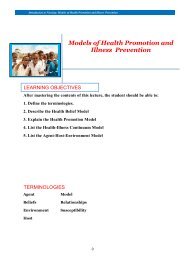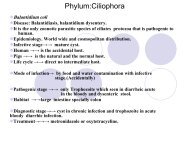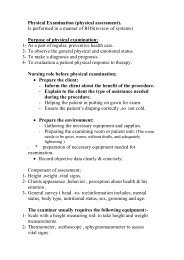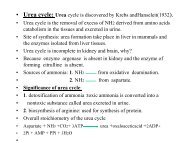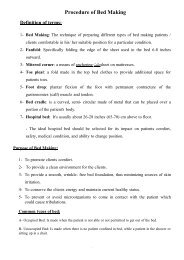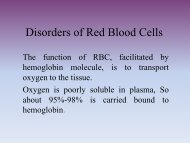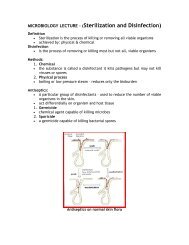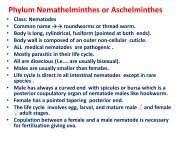Microbial Diseases of the Digestive System
Microbial Diseases of the Digestive System
Microbial Diseases of the Digestive System
You also want an ePaper? Increase the reach of your titles
YUMPU automatically turns print PDFs into web optimized ePapers that Google loves.
<strong>Microbial</strong> <strong>Diseases</strong> <strong>of</strong> <strong>the</strong><br />
<strong>Digestive</strong> <strong>System</strong>
Normal <strong>Microbial</strong> Flora <strong>of</strong> <strong>the</strong><br />
<strong>Digestive</strong> <strong>System</strong><br />
• Mouth<br />
• 1 ml saliva = millions <strong>of</strong> bacteria<br />
• Stomach and small intestine<br />
• Few organisms due to HCl and rapid movement<br />
<strong>of</strong> food<br />
• Large intestine<br />
• 100 billion bacteria per gram <strong>of</strong> feces<br />
• 40 % <strong>of</strong> fecal mass is microbial cell material<br />
• Lactobacillus, Bacteriodes, Enterobacter, E. coli.<br />
Proteus spp.
Bacterial <strong>Diseases</strong> <strong>of</strong> Lower G.I.<br />
• Infections<br />
• Pathogens enters G.I. Tract<br />
and multiples<br />
• Bacteria may penetrate <strong>the</strong><br />
intestinal mucosa or may<br />
pass to o<strong>the</strong>r systemic<br />
organs<br />
• Delay in appearance <strong>of</strong><br />
symptoms while pathogen<br />
increases in number or<br />
invades tissue<br />
• Usually a fever<br />
• Intoxications<br />
• Ingestion <strong>of</strong> a preformed<br />
toxin<br />
• Sudden onset <strong>of</strong> symptoms<br />
( few hours )<br />
• Fever not always present
Bacterial <strong>Diseases</strong> <strong>of</strong> Lower G.I.<br />
• Diarrhea – infections and intoxications<br />
• Blood or mucus - dysentery<br />
• Abdominal cramps, nausea and vomiting<br />
• Defense mechanism to rid body <strong>of</strong> harmful<br />
material<br />
• Gastroenteritis<br />
• Inflammation <strong>of</strong> stomach or intestinal mucosa
Campylobacter Gastroenteritis<br />
• Campylobacter jejuni<br />
• Gram (-), microaerophilic spiral<br />
• Most common cause <strong>of</strong> food borne illness in <strong>the</strong><br />
U.S.<br />
• Found in <strong>the</strong> intestines <strong>of</strong> many animals,<br />
especially poultry<br />
• Almost all retail chicken is contaminated<br />
• 60 % <strong>of</strong> cattle is contaminated<br />
• 2 million cases per year
Escherichia Gastroenteritis<br />
• 1. ETEC - enterotoxigenic E. coli<br />
• Not invasive<br />
• Enterotoxin – watery diarrhea<br />
• 2. EIEC - enteroinvasive E. coli<br />
• Invades intestinal wall<br />
• Inflammation, fever & Shigella-like dysentery<br />
• 3. EHEC -<br />
enterhemorrhagic E. coli<br />
• E. coli O157: H7<br />
• Found in intestines <strong>of</strong> animals, especially cattle<br />
• Hemorrhagic colitis – inflammation <strong>of</strong> colon with bleeding<br />
• HUS – Hemolytic Uremic Syndrome<br />
• Blood in urine leading to kidney failure (kidneys effected by toxin)
Shigellosis (Bacillary Dysentery)<br />
• Bacterial infection - Shigella sp. Gram (-), facultative, rods<br />
• Shigella sonnei<br />
• Shigella dysenteriae<br />
• Shigella flexneri<br />
• Shigella boydii<br />
Incubation period:<br />
• 12 hours to 2 weeks<br />
• Usually fever<br />
• Mild case <strong>of</strong> Shigellosis<br />
• Traveler’s Diarrhea<br />
• Montezuma’s Revenge<br />
• Green Apple Two Step<br />
• Shigella sonnei
Toxin<br />
• Shiga toxin - Kiyoshi Shiga<br />
• Unusually virulent<br />
• Bacteria invade intestinal mucosa – produce toxin<br />
• Severe diarrhea with blood in stool (dysentery)<br />
• Toxin inhibits Protein Syn<strong>the</strong>sis<br />
• Cells lining G.I. tract are shed<br />
• Up to 20 bowels movements a day
20,000 – 30,000 cases per year in U.S.<br />
5 – 15 deaths<br />
Shigella dysenteriae – more severe - Mortality Rate = 20 %
Salmonellosis<br />
(Salmonella Gastroenteritis)<br />
• Bacterial Infection – Salmonella sp.<br />
• Salmonella<br />
• Gram (-), facultative, non-spore forming rods<br />
• Found in G.I. Tract <strong>of</strong> humans and many animals<br />
• All are considered pathogenic<br />
• Taxonomy<br />
• Use serotype ra<strong>the</strong>r than species<br />
• Over 2000 serotypes (50 common in U.S.)<br />
• Salmonella arizonae<br />
• Salmonella atlanta<br />
• Salmonella berlin<br />
Salmonella brazil<br />
Salmonella pakistan<br />
Salmonella california
Salmonellosis<br />
• Incubation time 12 – 36 hours<br />
• Bacteria invade <strong>the</strong> intestinal mucosa and<br />
multiply<br />
• May pass thru mucosa into lymphatic or<br />
circulatory system and become systemic<br />
• Fever, abdominal pain, cramps and diarrhea
Salmonellosis<br />
• 1 billion Salmonella per gram <strong>of</strong> feces<br />
• Mortality rate < 1 %<br />
• Higher in infants and elderly<br />
• Recovery in a few days<br />
• Some may shed bacteria in feces for 6 months
Salmonellosis<br />
• Contamination<br />
• Meats, poultry, eggs, pet reptiles (turtles)<br />
• Undercooked or Raw Eggs<br />
• Hollandaise sauce<br />
• Cookie batter<br />
• Caesar salads<br />
• “Sunny side up” fried eggs
Typhoid Fever<br />
• Salmonella typhi - most virulent Salmonella<br />
• Only found in humans (feces)<br />
• <strong>System</strong>ic disease<br />
• Spreads thru body, found in blood, urine, feces<br />
• Mortality rate 1-2 %, used to be 10 %<br />
• Was common before days <strong>of</strong> proper sewage<br />
treatment<br />
• Still common in Third World countries
Typhoid Mary<br />
• Mary Mallon – cook in N.Y.<br />
• carrier<br />
• Responsible for several outbreaks and many<br />
deaths<br />
• Refused to leave her job<br />
• 1 – 3 % become chronic carriers<br />
• Microbe lives in gallbladder and is shed in feces
Cholera<br />
• Vibrio cholerae - Gram (-) curved rod<br />
• Endemic in Asia and India<br />
• Cholera toxin<br />
• Secretion <strong>of</strong> Cl - leads to H 2 O loss and diarrhea<br />
• 12 – 20 liters <strong>of</strong> fluid per day ( 3 – 5 gallons)
Food Poisoning from Seafood<br />
• Vibrio parahaemolytica<br />
• Found in salt H 2 O estuaries<br />
• Associated with poisoning from<br />
• Raw oysters<br />
• Shell fish<br />
• Shrimp<br />
• crabs
Staphylococcal Food Poisoning<br />
(Staphylococcal intoxication)<br />
• Ingesting an enterotoxin by Staph. aureus<br />
• Staphylococci<br />
• High resistance to heat<br />
• Resistant to drying out<br />
• Resistant to high osmotic pressures<br />
• Resistant to high salt conc.<br />
• Found in nasal passages and hands<br />
• Contaminate food
* 1 million bacteria per gram <strong>of</strong> food to produce enough enterotoxin to cause<br />
illness
Most reliable method <strong>of</strong> preventing<br />
Staphylococcal intoxication:<br />
• Adequate refrigeration during storage to<br />
prevent toxin production<br />
• Toxin<br />
• Triggers vomiting reflex center <strong>of</strong> brain<br />
• Abdominal cramps & diarrhea<br />
• Recovery usually complete in 24 hours.<br />
• Mortality rate – 0 % in healthy people
Peptic Ulcers<br />
• Helicobacter pylori – microaerophilic spiral<br />
• 30% - 50 % <strong>of</strong> normal pop. are infected, but only<br />
15% <strong>of</strong> those develop ulcers<br />
• urease<br />
• H 2 O + urea ammonia + CO 2<br />
• Urea Breath Test<br />
• Swallow radio-active urea<br />
• If positive, patient will exhale radio-active CO 2 within<br />
30 minutes
Hepatitis<br />
• Inflammation <strong>of</strong> <strong>the</strong> liver<br />
• Viral Hepatitis - 2 nd most frequently<br />
reported infectious disease in <strong>the</strong> U.S.<br />
• 5 different viruses<br />
• Hepatitis A<br />
• Hepatitis B<br />
• Hepatitis C<br />
• Hepatitis D<br />
• Hepatitis E
Hepatitis A<br />
(Infectious Hepatitis)<br />
• HAV<br />
ss RNA no envelope<br />
• Enters via oral route, multiplies in G.I. Tract spreads to liver<br />
• Virus is shed in feces<br />
• HAV is resistant to normal chlorine disinfectants used for<br />
water<br />
• HAV can survive several days on surfaces (cutting boards)<br />
• 50% <strong>of</strong> infections are subclinical<br />
• Symptoms<br />
• Nausea diarrhea abdominal discomfort<br />
• Fever chills jaundice<br />
• Recovery results in lifelong Immunity<br />
• No chronic Hepatitis A
Hepatitis B<br />
(Serum Hepatitis)<br />
• HBV<br />
ds DNA envelope<br />
• Transmitted by blood, semen, saliva, breast milk<br />
• 50% cases asymptomatic<br />
• Symptoms<br />
• Loss <strong>of</strong> appetite fever joint pains jaundice<br />
• 10% become chronic carriers <strong>of</strong> HBV<br />
• Chronic carriers are 200 times more likely to develop liver<br />
cancer<br />
• HBV Vaccination required in Illinois Schools<br />
• Recommended for high risk individuals (health care workers)
Hepatitis C<br />
(Non A, Non B Hepatitis)<br />
• HCV<br />
ss RNA envelope



